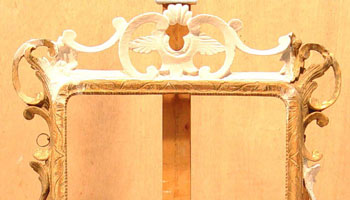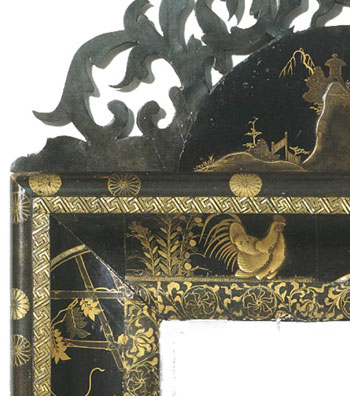Simon Blackwood Fine Arts
Frames Restoration and Manufacture
The effects of age
The restoration of frames generally involves the replacement of damaged mouldings or repairs to the basic structure – the most common deterioration being the effects of water and impacts on gesso (plaster) and wet or dry rot, infestations or impacts on the wood.
The same impurities in the atmosphere affect the frame as they do the picture it contains. Carved wood frames are generally more resilient to ill-treatment whereas cast compo and gesso mouldings are more fragile.
Solutions
Casts can be taken from the original remaining patterns to replace damaged or missing areas of moulding. Where this is not possible, new replacement mouldings can be carved or fashioned in wood, compo or gesso. Gilt and lacquer finishes can be cleaned and replaced to match the patina of age in the original.
Reproduction
New frames can be fashioned in carved wood or using our stock of moulds, finished in gold leaf or lacquer to any patina to suit the painting.
Origins
The origin of the picture frame may be traced back to the borders which first began to appear on tomb paintings three or four thousand years ago.
As Christian art developed, manuscripts were enclosed by decorative surrounds, these modified into carved book covers. With the introduction of altarpieces the frame had fully arrived to protect the paintings and to emphasise due reverence. The riches used were a glorification of the content and even became architecturally symbolic like the churches they occupied. The frame represented the separation of the divine from the mundane.
As paintings disseminated beyond the purely ecclesiastic domain and into the courts of Kings and nobles they became symbolic of power and wealth which was evident from their elaborate detail and superb craftsmanship and use of precious metals and stones.
From the 14th century onwards, models of the court frames proliferated as more secular paintings began to appear. They took on national characteristics and styles which we now tend to associate with "movements" in art.
The academic approach to finding the appropriate frame for a painting follows these national templates and movements although since the late 19th and 20th centuries aesthetic choices rather than historical accuracy have become the norm.
Mechanisation
Since the Victorian era the manufacture of frames became mechanised and many of the skills and processes have almost disappeared.
The basic structure of an ornate Renaissance frame would have been carved from Lime wood or other timber with good carving capabilities.
This form was then painted with gesso (a slaked plaster of Paris and animal glue formula) and again carved in the more intricate detail which gesso allowed.
Coloured "bole" was then applied onto the finished carving. This influences the colour of the gold leaf which could then be "burnished" to a mirror finish making it glisten and shine. The appearance was as if it were solid gold.
The carving of wooden frames which we associate with Holland and Germany, where lacquers were the predominant finish, became more repetitive but no less ornate. These latter are reminiscent of Chinese lacquer work.
Once mechanisation had taken off a new economical form of reproduction took shape and the wood carver turned his skills to fashioning wooden moulds which could be cast repetitively in a resinous derivative of gesso known as "compo".
This and the lacquered frame form the two basic templates for most contemporary picture frames.
Value
Period carved wood frames are highly sought after now and therefore command greater prices than their "compo" counterparts although the latter exhibit as much of the woodcarvers' skill. The replacement value of such gems is on the increase as fewer and fewer craftsmen are trained and as, at the same time, the general market demand diminishes.


Carved wood mirror frame showing (above) replaced
carved moulding and (below) cleaned original with
new matched and finished gilded insets.

Reproduction period "compo" frame made by Simon Blackwood Fine Ats

Detail of Chinese lacquer picture frame.

17th century Spanish carved wood frame reproduction by Simon Blackwood Fine Arts.